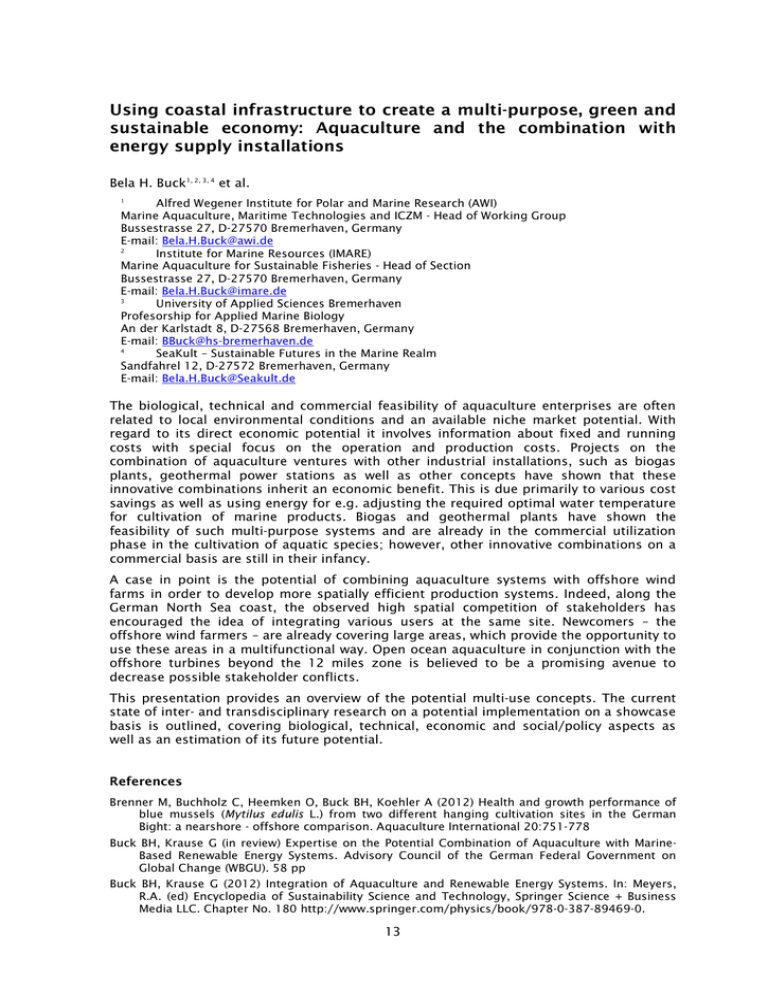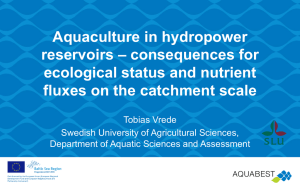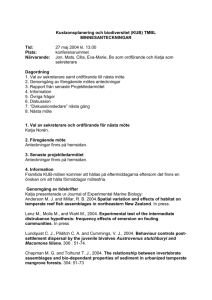Using coastal infrastructure to create a multi-purpose, green and
advertisement

Using coastal infrastructure to create a multi-purpose, green and sustainable economy: Aquaculture and the combination with energy supply installations Bela H. Buck1, 2, 3, 4 et al. Alfred Wegener Institute for Polar and Marine Research (AWI) Marine Aquaculture, Maritime Technologies and ICZM - Head of Working Group Bussestrasse 27, D-27570 Bremerhaven, Germany E-mail: Bela.H.Buck@awi.de 2 Institute for Marine Resources (IMARE) Marine Aquaculture for Sustainable Fisheries - Head of Section Bussestrasse 27, D-27570 Bremerhaven, Germany E-mail: Bela.H.Buck@imare.de 3 University of Applied Sciences Bremerhaven Profesorship for Applied Marine Biology An der Karlstadt 8, D-27568 Bremerhaven, Germany E-mail: BBuck@hs-bremerhaven.de 4 SeaKult – Sustainable Futures in the Marine Realm Sandfahrel 12, D-27572 Bremerhaven, Germany E-mail: Bela.H.Buck@Seakult.de 1 The biological, technical and commercial feasibility of aquaculture enterprises are often related to local environmental conditions and an available niche market potential. With regard to its direct economic potential it involves information about fixed and running costs with special focus on the operation and production costs. Projects on the combination of aquaculture ventures with other industrial installations, such as biogas plants, geothermal power stations as well as other concepts have shown that these innovative combinations inherit an economic benefit. This is due primarily to various cost savings as well as using energy for e.g. adjusting the required optimal water temperature for cultivation of marine products. Biogas and geothermal plants have shown the feasibility of such multi-purpose systems and are already in the commercial utilization phase in the cultivation of aquatic species; however, other innovative combinations on a commercial basis are still in their infancy. A case in point is the potential of combining aquaculture systems with offshore wind farms in order to develop more spatially efficient production systems. Indeed, along the German North Sea coast, the observed high spatial competition of stakeholders has encouraged the idea of integrating various users at the same site. Newcomers – the offshore wind farmers – are already covering large areas, which provide the opportunity to use these areas in a multifunctional way. Open ocean aquaculture in conjunction with the offshore turbines beyond the 12 miles zone is believed to be a promising avenue to decrease possible stakeholder conflicts. This presentation provides an overview of the potential multi-use concepts. The current state of inter- and transdisciplinary research on a potential implementation on a showcase basis is outlined, covering biological, technical, economic and social/policy aspects as well as an estimation of its future potential. References Brenner M, Buchholz C, Heemken O, Buck BH, Koehler A (2012) Health and growth performance of blue mussels (Mytilus edulis L.) from two different hanging cultivation sites in the German Bight: a nearshore - offshore comparison. Aquaculture International 20:751-778 Buck BH, Krause G (in review) Expertise on the Potential Combination of Aquaculture with MarineBased Renewable Energy Systems. Advisory Council of the German Federal Government on Global Change (WBGU). 58 pp Buck BH, Krause G (2012) Integration of Aquaculture and Renewable Energy Systems. In: Meyers, R.A. (ed) Encyclopedia of Sustainability Science and Technology, Springer Science + Business Media LLC. Chapter No. 180 http://www.springer.com/physics/book/978-0-387-89469-0. 13 Buck BH, Dubois J, Ebeling M, Franz B, Goseberg N, Krause G, Schaumann P, Schlurmann T, Schmidt J, Wefer L (2012a) Projektbericht „Multiple Nutzung und Co-Management von OffshoreStrukturen: Marine Aquakultur und Offshore Windparks - Open Ocean Multi-Use (OOMU). Gefördert durch das BMU - Förderkennzeichen 325206. Project coordination: IMARE GMBH Germany. 255 pp. Buck BH, Grote B, Strieben S (2012b) Aquakultur-Site-Selection für die nachhaltige und multifunktionale Nutzung von marinen Gebieten in stark genutzten Meeren am Beispiel der Nordsee - Offshore Site-Selection. Gefördert durch das BMELV - Förderkennzeichen GZ: 51106.01-28-1-73.009-10. Project coordination: AWI - Germany. 29 pp. Buck BH, Ebeling M, Michler-Cieluch T (2010) Mussel cultivation as a co-use in offshore windfarms: potential and economic feasibility. Aquaculture Economics & Management , 14:255-281. Buck BH, Krause G, Michler-Cieluch T, Brenner M, Buchholz C, Busch JA, Fisch R, Geisen M, Zielinski O (2008) Meeting the quest for spatial efficiency: Progress and Prospects of Extensive Aquaculture within Offshore Wind Farms. Helgoland Marine Research, 62: 269-281. Buck BH, Krause G, Rosenthal H (2004) Extensive open ocean aquaculture development within wind farms in Germany: the prospect of offshore co-management and legal constraints. Ocean & Coastal Management , 47(3-4), 95-122. Krause G, Griffin RM, Buck BH (2011) Perceived Concerns and Advocated Organisational Structures of Ownership Supporting ‘Offshore Wind Farm – Mariculture. In: Krause G (Ed.): From Turbine to Wind Farms - Technical Requirements and Spin-Off Products. InTech-Publishing. Michler-Cieluch T, Krause G, Buck BH (2009) Marine Aquaculture within Offshore Wind Farms: Social Aspects of Multiple Use Planning. GAIA: 18, 2, 158-162. 14

